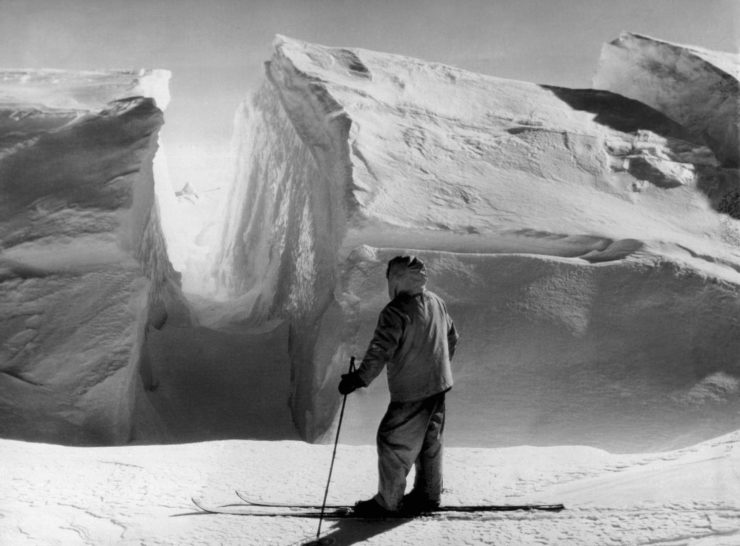
Russell G. Frazier pauses during a Byrd expedition of the Antarctic in 1941.
As a near-spring Nor’easter hit New England this week, we showcased two recent stories about polar exploration. What intrigued me were the very different perspectives of the writers and subjects. In David Grann’s piece on explorer Henry Worsley, the focus is on endurance and suffering. In Eva Holland’s first-person story about attending an “extreme polar” course near the Arctic Circle, she references the “sufferfest” of much male exploration and instead tries to focus on the joys — and humor. Vive la différence.
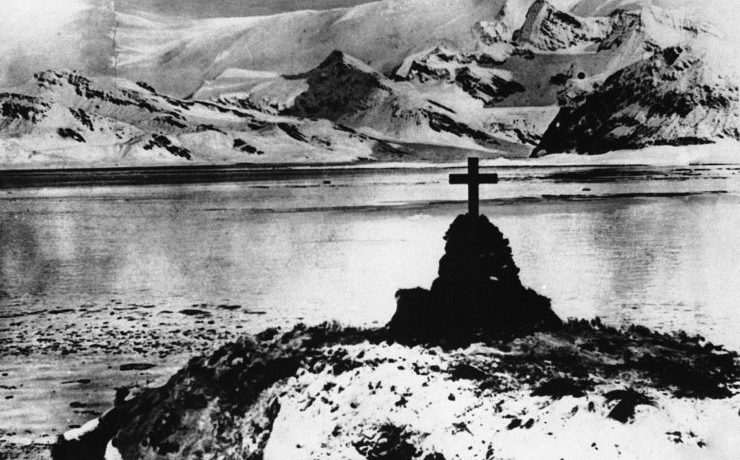
The grave of Ernest Shackleton in the Antarctic in an undated photo.
Writing through a whiteout: David Grann and “The White Darkness.” This wonderful interview by Steve Oney gets the story behind Grann’s epic New Yorker story about a doomed polar explorer. Grann admits he went through his own blizzard in the writing process: “Every story has its challenges, but halfway through the piece, I got caught in a whiteout. It became very difficult assimilating so much information.” And this quote is wonderful: “I rue that we now live in a world without documents and handwritten accounts. I couldn’t have done this story without Henry’s common book and diary. Social media is ephemeral. It’s spotty and it disappears. With Henry, I had the actual, physical items. Because of that I was able to reconstruct his days and thoughts with a specificity that is increasingly elusive in reporting. No matter how important the story you’re telling, you can’t tell it when there aren’t records.”
The soundtrack: “Whiteout Conditions,” by the New Pornographers. If I hadn’t seen the band name, I would have thought this was a song by Flock of Seagulls. Not that that’s necessarily a bad thing, but the ’80s will not die, will they?
One Great Sentence
“If I were hauling 600 miles across the Arctic, I’d choose J. for stamina and his uncomplaining nature; A. for her medical skills and ability to play music; N. because he’s optimistic and multilingual; H. for her understanding of the natural world; T. for her scientific mind, though she probably would not hesitate to fry and eat my liver if I died.”
Leanne Shapton, The New York Times Magazine, March 20, 2016. Read why we think it’s great.
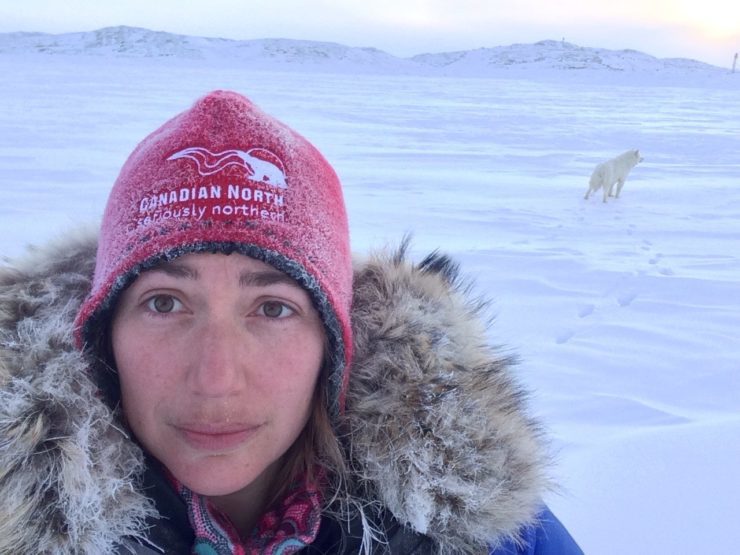
Eva Holland, not suffering (much) near the Arctic Circle.
Eva Holland and “Get Schooled in the No-Nonsense Art of Survival.” In this Why’s This So Good? essay, contributor Julia Shipley celebrates Holland’s sense of wonder (and sense of humor) in her story for Outside magazine about a polar exploration training course. Holland, she writes, “readily admits that as she stumbled out to her tent that first night in minus-15 weather, she was ‘intending to suffer.'” But the mother-daughter team who run the course have other ideas. Instead, Shipley says, “they focus on fun. Holland translates ‘fun’ for those of us who think an amble through the Arctic sounds like anything but: ‘To thrive, Matty believes, you have to find the beauty and wonder in polar travel instead of dwelling on the obstacles and suffering.'” And if you thought it would be impossible to be lyrical about a midnight pee near the Arctic Circle, I’m here to tell you you’re wrong.
The soundtrack: “Girls Just Want to Have Fun,” by Cyndi Lauper. Try to get this out of your head today. That hiccup thing she does. The way she stretches the word “fun” into two syllables. The empowering message. (Although I could do without the plinky ’80s synth…) Lauper rules.
What I’m reading online: The Quest for the Collision Zone: An Arctic Exploration, by William E. Glassley. Longreads ran this excerpt from a book by Glassley, a geologist. Much of the piece is quite scientific, but I loved the moments of wonder, like this description: “But farther down the fjord, a thick horizontal blade of sharp turquoise blue cut across the land, as though a giant painter had saturated a brush and slashed the ground with it. The blue was brilliant and intense, a pure distillation of color. It seemed to stretch hundreds of feet into the air and was painted across the land for miles. Within that absolutely horizontal turquoise stripe floated vertical columns of white, gray, tan, and green, looking for all the world like skyscrapers in a city miles away — a shimmering blue Oz resting on the frigid waters of the fjord.”
After 30 Years, an Island and Its Sole Inhabitant Face an Uncertain Future, by Vittoria Traverso. You might not see the words “Italian island” and think of surviving against the brutal elements. But in this story about a man who has lived alone on the island for decades, the hardships are vivid. Here’s a description of a winter storm: “The wind was so strong and made a howling sound that I have never heard before,” he says. Waves reached 18 feet and were breaking far beyond the beach. “I realized that humans are nothing against nature,” he says, with a taut voice. “Even with all of our technology, we are nothing but small ants.”
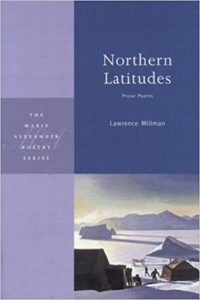 What’s (almost) on my bedside table: “Northern Latitudes,” by Lawrence Millman. I couldn’t get a copy of this before I wrote the newsletter, but contributor Julia Shipley (practically a one-woman show this week, with her One Great Sentence and essay on Eva Holland, above) sent me this wonderful passage, and I can’t wait to read the book. Now I know of two writers who’ve been lyrical about peeing in the middle of the night in the snow: “My piss crackles on the hard snow, raising a delicate haze of steam. Overhead I watch the blue-green streams of the aurora open and close, open and close, like a celestial concertina. The stars are kicked-up flakes of snow, glistening pinpricks in the dark abyss of the sky. I gaze at them until the wind sings these words to my nearly numb flesh: now that you’ve answered your call it’s retreat or die. So back I go, half frozen yet fully blessed, back to my tent’s cozy, life giving unloveliness.”
What’s (almost) on my bedside table: “Northern Latitudes,” by Lawrence Millman. I couldn’t get a copy of this before I wrote the newsletter, but contributor Julia Shipley (practically a one-woman show this week, with her One Great Sentence and essay on Eva Holland, above) sent me this wonderful passage, and I can’t wait to read the book. Now I know of two writers who’ve been lyrical about peeing in the middle of the night in the snow: “My piss crackles on the hard snow, raising a delicate haze of steam. Overhead I watch the blue-green streams of the aurora open and close, open and close, like a celestial concertina. The stars are kicked-up flakes of snow, glistening pinpricks in the dark abyss of the sky. I gaze at them until the wind sings these words to my nearly numb flesh: now that you’ve answered your call it’s retreat or die. So back I go, half frozen yet fully blessed, back to my tent’s cozy, life giving unloveliness.”
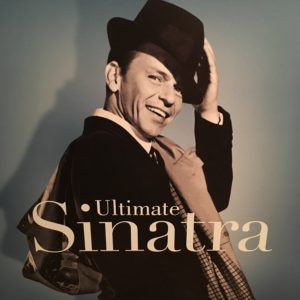 What’s on my turntable: “Ultimate Sinatra,” by Frank Sinatra. For Polar Week, I thought a cool customer like Sinatra would do the trick. I mean, just look at that cover: the hat at a jaunty angle, the coat slung over his shoulder like he’s just come home from an adventure. And the inside gatefold photo is even better: He’s practicing with a band wearing a suit, a silver tie and a different hat with a silver band around it. And of course the music is v. cool too, including two of my favorites, “Come Fly With Me” and “Fly Me to the Moon.” (Unfortunately it also includes one of his worst, “Love and Marriage.”)
What’s on my turntable: “Ultimate Sinatra,” by Frank Sinatra. For Polar Week, I thought a cool customer like Sinatra would do the trick. I mean, just look at that cover: the hat at a jaunty angle, the coat slung over his shoulder like he’s just come home from an adventure. And the inside gatefold photo is even better: He’s practicing with a band wearing a suit, a silver tie and a different hat with a silver band around it. And of course the music is v. cool too, including two of my favorites, “Come Fly With Me” and “Fly Me to the Moon.” (Unfortunately it also includes one of his worst, “Love and Marriage.”)
If you want to chat about storytelling (or music), I’m Storyboard editor Kari Howard, and you can reach me at editor@niemanstoryboard.org. Or you can find me at @karihow on Twitter.


